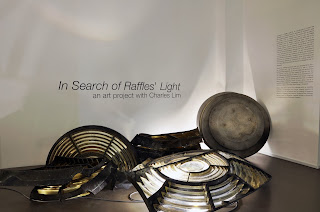Diary of an NUS Museum Intern: Dana Gan
Note: Diary of an NUS Museum Intern is
a series of blog posts written by our interns about their experiences
during the course of their internships. Working alongside their mentors,
our interns have waded through tons of historical research, assisted in
curatorial work, pitched in during exhibition installations and
organised outreach events! If you would like to become our next intern, visit our internship page for more information!
-
The internship in NUS Museum for the past one month has been
filled with many new enriching experiences. We focused on is
the archaeology section in the museum. This section consists of sherds from
Singapore historical sites (eg: Fort Canning), shipwrecks (eg: Pinggang shipwreck) as well as other Southeast Asian countries.
In the process, we learnt how to stand in the shoes of students and hence create activities that are interesting for them. Secondly, we have realized how important teamwork and cooperation are in the process. The task has enabled us to value our working (studying) partners more which I think is essential for our upcoming Project Work course in JC1. Hence, I believe the WOW! Attachment has really prepared me for JC.
Apart from these tasks, we also went on two field trips to the National Museum of Singapore and the NUS Baba House. Firstly, for the National Museum of Singapore, we went for the archaeology exhibition on the B1 floor, hoping to learn some additional information about Singapore historical sites and archaeology. We also went for the “Singapura: 700 Years” exhibition near the archaeology exhibition, hoping to learn more about the Singapore history (since the three of us are foreigners).
In January 2015, three JC 1 students, Dana Gan, Kim Soh Won and Liang Siyi, interned with us for a month as part of Temasek Junior College's Wonder. Observe. Weave! (WOW!) Attachment Programme. Across their four-week attachment, they were tasked to do research and craft educational activities for the primary level based on our new Sherd Library.
-
Our main task was to come up with a proposal consisting of
different worksheets for students from lower primary, upper primary and
secondary schools so that they can have a better understanding of the museum
and the exhibitions going on. The three of us have edited the proposal four times and we have
really made great progress every time after discussing with our external
mentor, Ms Kuek.
The following is a map we created showing the locations of historical sites in Singapore:
The following is a map we created showing the locations of historical sites in Singapore:
We developed this question because we would like the
students to infer that the five historical sites all gathered near the Singapore
River. It indicates that trading has taken place in the regions near the
Singapore River and objects from different countries were once exchanged there
and that is why a large number of shards of different origins could be
excavated in these regions.This question requires the students to be observant and we
believe that the ability to observe and infer is essential for students.
In the process, we learnt how to stand in the shoes of students and hence create activities that are interesting for them. Secondly, we have realized how important teamwork and cooperation are in the process. The task has enabled us to value our working (studying) partners more which I think is essential for our upcoming Project Work course in JC1. Hence, I believe the WOW! Attachment has really prepared me for JC.
Apart from these tasks, we also went on two field trips to the National Museum of Singapore and the NUS Baba House. Firstly, for the National Museum of Singapore, we went for the archaeology exhibition on the B1 floor, hoping to learn some additional information about Singapore historical sites and archaeology. We also went for the “Singapura: 700 Years” exhibition near the archaeology exhibition, hoping to learn more about the Singapore history (since the three of us are foreigners).
The NUS Baba House trip was the most fun field trip I have had in the two years I have been in Singapore. The NUS Baba House showcases Peranakan
history, architecture and heritage. The guide was enthusiastic and humorous and
we have really learnt a lot about the Peranakan life in the past. The
decor inside the house was truly amazing and it gripped our attention
right away. We also gained understanding of the female discrimination during the
time. I think we should not take the relative gender equality we have nowadays
for granted. We should look more to history and continue to make efforts to
make this world a more equal, harmonious place.
Lastly, I also attended the opening ceremony of the exhibition Curating Lab: Phase 03 at NUS Museum. That night was unforgettable. After the ceremony, we had a better understanding of contemporary art and the debates over its importance and position in society.
This month’s experience has been really great and exciting, and I am thankful for the chance to be an intern at NUS Museum.
Lastly, I also attended the opening ceremony of the exhibition Curating Lab: Phase 03 at NUS Museum. That night was unforgettable. After the ceremony, we had a better understanding of contemporary art and the debates over its importance and position in society.
This month’s experience has been really great and exciting, and I am thankful for the chance to be an intern at NUS Museum.







Comments
Post a Comment